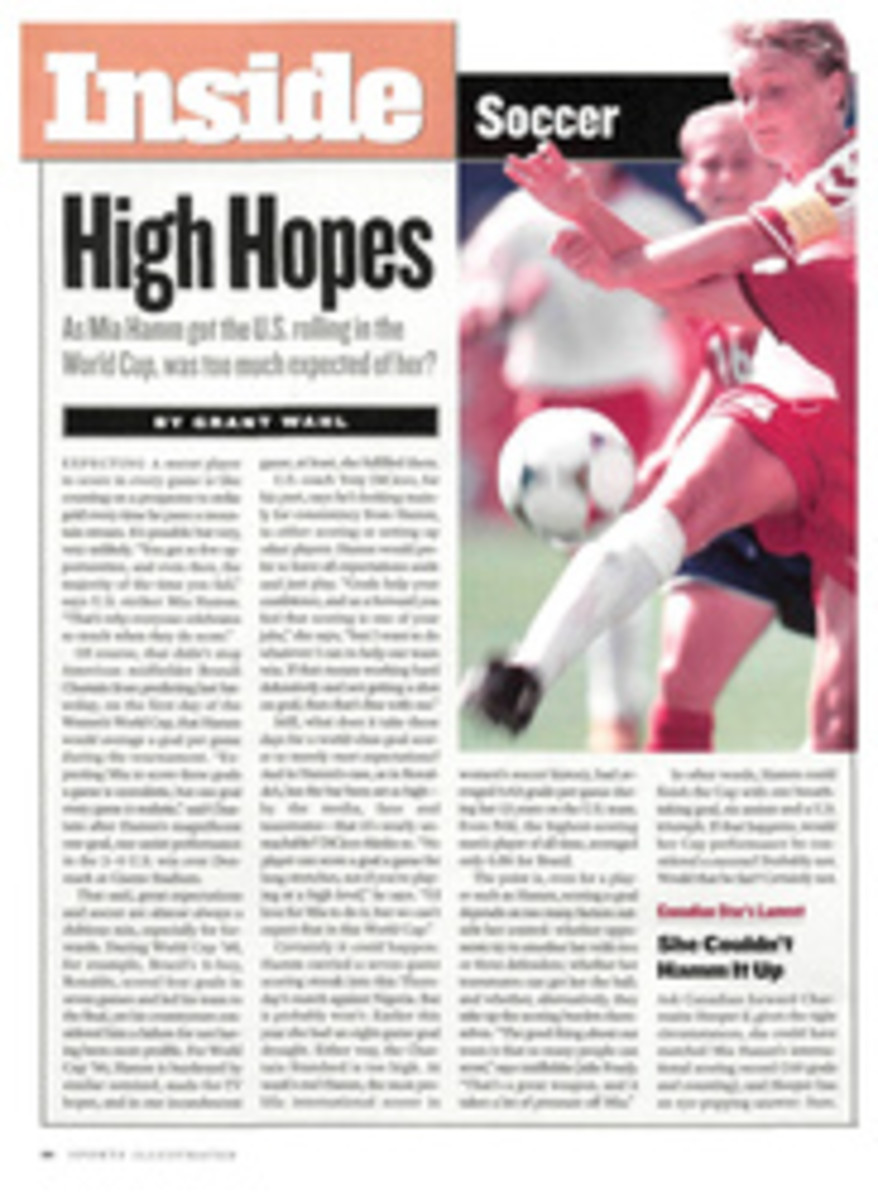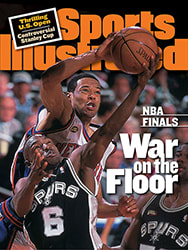
Notebook
Europe and the U.S. Open
CONTINENT ADRIFT
It was supposed to be Europe's U.S. Open, the first won by a
player from the continent since Tony Jacklin in 1970. The game
at Pinehurst No. 2 wasn't target golf but follow the bouncing,
rolling ball. As it turned out, Europe's most indelible shot
last week was not a bump-and-run but a punch.
In Thursday's first round, pretournament favorite Jose Maria
Olazabal hit only five of 14 fairways, seven of 18 greens in
regulation and, after making a double bogey on the 18th and
signing for a 75, one of four walls in his hotel room with his
fist. When Olazabal was told he had broken his right hand--he
tried to hit balls on Friday morning before withdrawing--the
bizarre rang familiar. In the post-Jacklin futility file, the
Ollie-wall episode joins those of Seve Ballesteros, who was DQ'd
for missing his tee time in 1980, and Colin Montgomerie, who in
'92 accepted congratulations on his victory at Pebble Beach only
to watch Tom Kite come in with a lower score.
Ollie's 21 fellow European tourists didn't fare much better; a
meager eight made the cut. Lee Westwood, who has been bothered by
a sore right shoulder but last week pronounced himself fit, was
the most notable casualty, making three birdies and fewer friends
while shooting 73-76. When a reporter noted before the tournament
that European players might do well, Westwood tersely replied,
"We have nothing like this in Europe. I don't know why somebody
has the impression it's going to suit the European player. That's
just a proviso in case one of us wins."
Paired with Tiger Woods and Corey Pavin, Westwood displayed the
ears of a rabbit, the eyes of an owl and the putting stroke of a
mason. In Thursday's first round, after he missed a short par
putt on the 222-yard par-3 6th hole, Westwood glared at a
greenside photographer and muttered an expletive. He bogeyed two
of the next three holes, and after the round, when asked about
the lensmen--cue violins--he said, "They seemed to be under the
impression that there was only one person in the three ball."
Montgomerie was in better spirits on Thursday after he salvaged
a 72 with birdies on numbers 17 and 18. But when a reporter
asked him what he shot, Monty reacted as if he'd been asked who
picked out his shirt (a query he'd answered in evident disbelief
earlier in the week). Said Montgomerie, "Is that the first
question? What did I shoot? That's the best one yet."
After round 1 Darren Clarke eyed the scores--Thomas Bjorn, Sven
Struver and Mathias Gronberg had all shot 70, three strokes off
the pace--and wondered what had gone wrong. "I thought there
would have been more of us at the top of the leader board,"
Clarke said. On Friday, it got worse. Westwood took 34 putts and
was done. Bjorn and Gronberg each shot 78 and also missed the
cut. That left Clarke and Miguel Angel Jimenez, who each shot 70
in the second round, as the only ones within six shots of the
lead, and Phillip Price and Montgomerie seven back. None
factored on the weekend, although Clarke tied for 10th.
Montgomerie, who turned 36 on June 23, finished 15th. He is 0
for 55 as a pro in the U.S., and still majorless. Westwood
sounded as if he'd been taking grumpy lessons from Monty. Nick
Faldo, who turns 42 next month, shot 74-74 and missed the cut.
Olazabal is iffy for the British Open in three weeks as the
focus shifts from his foot to his hand. With only two of the
last 21 majors won by Europeans, compared with seven of the 21
before that, the Euros might consider examining their heads.
Clock-Watching Controversy
USGA'S TIMERS COULD BE TAMER
For the second straight year, Payne Stewart was in the final
pairing on the back nine of the U.S. Open when he learned he was
being watched like a soft-boiled egg by the USGA. He and partner
Phil Mickelson were told by USGA vice president Trey Holland
that they would be on the clock on the 12th hole because they
had fallen too far behind the twosome in front of them. If they
didn't speed up, they would be dealt a two-stroke penalty for
turtle-like play on the turtle-back greens.
In '98, Stewart simmered when he was told he was on the clock
after being denied relief from a sand-filled divot on the 12th
hole at Olympic. He bogeyed that hole and two more to finish one
stroke behind Lee Janzen.
When Holland approached him on Sunday, Stewart snapped, "Don't
tell me you're putting us on the clock." He bogeyed number 12,
but this time he regained his composure and played the final six
holes in one under to win.
COLOR PHOTO: DOUG MILLS/AP TKO'd Olazabal's Open ended when he, literally, hit the wall.
THREE COLOR PHOTOS: MARK T. MURRAY (3)
Threesomes
What do these players have in common?
--Jesper Parnevik
--Steve Stricker
--Chris Tidland
They were the only players at last week's U.S. Open to make
eagles, all of which came on par-4s. Parnevik made a 2 at the
13th hole on Thursday, Stricker a 2 at the 3rd on Saturday and
Tidland a 2 at the 3rd on Friday.
Feedback
Does the focus on the short game make the '99 Open more
entertaining than others?
More 77%
Less 8%
Same 15%
--Based on 668 responses to our informal survey
Next question: Was John Daly correct in saying Pinehurst was
unfair? Vote at www.cnnsi.com/golf.
Numbers
A look at the last 10 U.S. Open champions shows that they were
often short off the tee but, with the exception of Steve Jones in
'96, they all cracked the top 10 in greens in regulation or putts
per GIR to win.
GIR PUTTS DRIVING
Payne Stewart 8 1 50
Lee Janzen 1 6 11
Ernie Els 1 15 55
Steve Jones 4 15 7
Corey Pavin 4 6 67
Els 1 10 5
Janzen 21 5 66
Tom Kite 25 3 43
Stewart 2 24 47
Hale Irwin 1 14 36
AVG. RANK 12.6 9.9 38.7
Faces
Aree Wongluekiet, Bradenton, Fla.
Naree Wongluekiet, Bradenton, Fla.
Aree and Naree, 13-year-old identical twins who are both former
Junior World champions, finished first and fourth, respectively,
in the Lucent Technologies Girls Junior, one of the major
American Junior Golf Association tournaments. Competing in her
first AJGA event, Aree shot a tournament-record 13-under 206 on
the Randolph Park North Course in Tucson to win by three strokes
over Miriam Nagl, 18, of Berlin, Germany. Naree, older than Aree
by nine minutes, had a 214 total. The children of a Korean
father and a Thai mother, the Wongluekiets emigrated from
Bangkok to Bradenton two years ago.
Chan Wongluekiet, Bradenton, Fla.
Chan, 16, the older brother of Aree and Naree, tied for third in
the ClubCorp Junior in Hilton Head Island, S.C. He shot a
three-under 213 at the Melrose Course on Daufuskie Island and
finished four shots behind winner Sean O'Hair, also of Bradenton.
Submit FACES candidates to golfplus.cnnsi.com/faces.

